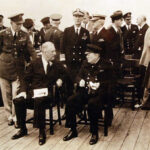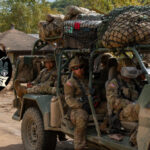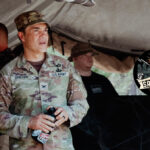
It all started with a Twitter thread. Matthew Ford set his trap with a few sly comments about the ever controversial S.L.A. Marshall (SLAM) and three intrepid historians couldn’t help themselves but to jump into the fray. Listen now to part 2 with Matthew, Robert Engen, Rob Thompson and our DUSTY SHELVES editor Tom Bruscino. The four of them debate the merits and pitfalls of SLAM’s works, the different approaches they each use in their research, the role of rhetoric in military change and just a general ribbing back and forth between historians and journalists.
At no point does John Pershing wander off to the front in the Meuse-Argonne or Saint-Mihiel or anywhere else and go to guys like, hey, you guys need to fix bayonets, fire your rifles, and take that position.
Podcast: Download

Matthew Ford is a senior lecturer at the University of Sussex, now awaiting publication of his second book, Radical War: Data, Attention and Control in the 21st Century. His first book is on small arms innovation called Weapon of Choice: Small Arms and the Culture of Military Innovation.
Robert Engen is an Assistant Professor in defense studies at the Canadian Forces College and the author of two books on infantry in the Second World War and multiple articles and chapters on S.L.A. Marshall.
Rob Thompson is a historian with the films team at Army University Press out of Fort Leavenworth. He is the author of Clear, Hold, and Destroy: Pacification in Phú Yên and the American War in Vietnam.
Thomas Bruscino is an Associate Professor in the Department of Military, Strategy, Planning and Operations at the U.S. Army War College and the Editor of the DUSTY SHELVES series.
The views expressed in this presentation are those of the speakers and do not necessarily reflect those of the U.S. Army War College, U.S. Army, or Department of Defense.
Photo Description: Samuel Lyman Atwood Marshall (July 18, 1900 – December 17, 1977) was a chief U.S. Army combat historian during World War II and the Korean War.
Photo Credit: Archive of the U.S. War Department, Unknown military photographer of the Signal Corps





I believe that the outcome in Vietnam was very much the result of the impact of Korea, where getting as many soldiers to fire their weapons (esp. during the final two years of the war) was a paramount concern. Van Fleet’s emphasis on using firepower to spare American lives (both in terms of small arms and artillery (re the tremendously increased artillery “Van Fleet Rate of Fire” that caused artillery ammunition shortages during this period) played a significant role in this aspect, which made sense for a situation in which US troops had largely settled into static defensive positions. This approach did not make nearly as much sense in the more fluid actions in Vietnam. (Note: I wrote an article published in the January 2002 Journal of Military History on Marshall’s ratio of fire in Korea.)
The article “Shoot, Soldier!” in the April 1945 Infantry Journal says that 1) Marshall was right, GIs weren’t firing their rifles in combat, 2) the problem was reported back from the fighting fronts with increasing insistency throughout the war, and 3) new training methods would be needed to correct it. This was published in the Infantry School’s official journal two years before “Men Against Fire” appeared. Has it ever been cited as evidence in the fire-ratio controversy?